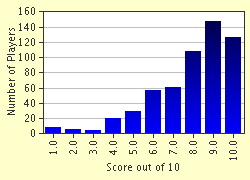Quiz Answer Key and Fun Facts
1. What did Renaissance architects and sculptors primarily draw their inspiration from?
2. Respectively, what are Frank Lloyd Wright, Henry Moore and Jackson Pollock best known as?
3. As well as being a great advance in painting, this fifteenth century device also possibly helped Columbus get to the New World. What was it?
4. "Abstraction" in painting involves the absence of what?
5. Which of these sculptures wasn't done in ancient Greece or ancient Rome?
6. What is "Arrangement in Grey and Black No. 1: Portrait of the Artist's Mother" better known as?
7. What is at the entrance to the Louvre museum in Paris?
8. What's the most famous painting in the Louvre?
9. Who painted the "Water Lilies" series of paintings: Monet or Manet?
10. Picasso's "Guernica" was painted as a direct reaction to an event in which war?
Source: Author
anselm
This quiz was reviewed by FunTrivia editor
agony before going online.
Any errors found in FunTrivia content are routinely corrected through our feedback system.

